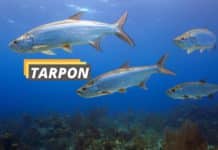You’re probably familiar with different names of fish found in the fresh or marine waters of North America. But do you know the scientific name of salmon? Or that “trout” is called “char” in Canada? In this blog post, we will provide a comprehensive list of scientific names of fish.
We will also discuss some interesting facts about this naming system and its importance. So whether you’re an experienced fisherman or just someone who enjoys learning about new things, you’ll love this blog.
What Are the Scientific Names for Common Fish?
There are over 20,000 fish in the world, each with its scientific name. Here is a list of scientific names for common fish.
| Common Name | Scientific Names |
|---|---|
| Alewife | Alosa pseudoharengus |
| Amberjack | Seriola dumerili |
| Amberjack (yellowtail) | Serola lalandi |
| American eel | Anguilla rostrata |
| Arctic char | Salvelinus alpinus |
| Arctic grayling | Thymallus arcticus |
| Atlantic cod (Baltic) | Gadus morhua |
| Atlantic croaker (Baltic) | Micropogonius undulatus |
| Atlantic herring | Clupea harengus |
| Atlantic halibut | Hippoglossus hippoglossus |
| Atlantic mackerel | Scomber scombrus |
| Atlantic menhaden | Brevoortia tyrannus |
| Atlantic seasnail | Liparis atlanticus |
| Atlantic salmon | Salmo salar |
| Atlantic tomcod | Microgadus tomcod |
| Australian pilchard | Sardinops sagax neopilchardus |
| Ayu | Plecoglossus altivelis |
| Baramundi perch | Lates calcarifer |
| Bengal danio (sind) | Devario devario |
| Betta | Betta splendens |
| Bighead carp | Aristichthys nobilis |
| Black bullhead | Ameiurus melas |
| Black carp | Mylopharyngodon piceus |
| Black seabream (porgy) | Hypophthalmichthys schlegeli |
| Bleak | Alburnus alburnus |
| Blue catfish | Ictalurus furcatus |
| Blue tilapia | Oreochromus aureus |
| Bluegill | Lepomis macrochirus |
| Bream (common) | Abramis brama |
| Brook trout | Salvelinus fontinalis |
| Brown bullhead | Ameiurus nebulosus |
| Brown-spotted grouper | Epinephelus lovina |
| Brown trout | Salmo trutta |
| Channel catfish | Ictalurus punctatus |
| Chinook salmon | Oncorhynchus tshawytscha |
| Chum salmon | Oncorhynchus keta |
| Coho salmon | Oncorhynchus kisutch |
| Common carp | Cyprinus carpio |
| Common minnow (Eurasian) | Phoxinus phoxinus |
| Common shiner | Lulilus cornutus |
| Cutthroat trout | Oncorhynchus clarki |
| Dab (North Sea) | Pleuronectus limanda |
| Damsel fish | Chrysiptera sp. |
| Doctorfish | Labroides dimidatus |
| Emerald shiner | Notropis atherinoides |
| Estuarine grouper | Epinephelus tauvina |
| European catfish (wels) | Silurus glanis |
| European perch | Perca fluviatilis |
| European flounder | Platichthys flesus |
| European seabass | Morone (Decentrarchus) labrax |
| European smelt | Osmerus eperlanus |
| European eel | Anquilla anquilla |
| Fathead minnow | Pimephales promelas |
| Formosa snakehead | Channa maculata |
| Gourami | Osphronemus goramy |
| Gilthead seabream | Sparus auratus |
| Gizzard shad | Dorosoma cepedianum |
| Glass knifefish | Eigenmannia virescens |
| Gold sing wrasse | Ctenolabrus rupestris |
| Golden shiner | Notemigonus crysoleucas |
| Goldfish (Crucian carp) | Carassius auratus |
| Grass carp | Ctenopharyngodon idella |
| Grayling | Thymallus thymallus |
| Greenback flounder | Rhombosolea tapirina |
| Gudgeon (topmouth) | Gobio gobio |
| Gulf killifish | Fundulus grandis |
| Gulf menhaden | Brevoortia patronus |
| Guppy | Poecilia reticulata |
| Hardhead catfish | Arius felis |
| Ide (Orfe) | Leuciscus idus |
| Indian glassfish | Chanda ranga |
| Itipa mojarras | Diapterus rhombeus |
| Japanese catfish | Silurus asotus |
| Japanese eel | Anguilla japonica |
| Japanese striped knife jaw | Oplegnathus faciatus |
| Kelp (red) grouper | Epinephelus moora |
| Lake sturgeon | Acinpenser fulvescens |
| Lake trout | Salvelinus namaycush |
| Macquarie perch | Macquaria australasica |
| Masu (yamame, cherry salmon) | Oncorynchus masou |
| Mozambique tilapia | Oreochromis mossambicus |
| Mosquitofish | Gambusia affinis |
| Mountain galaxias | Galaxias olidus |
| Muskellunge | Esox masquinongy |
| Neon tetra | Paracheirodon innesi |
| Nile tilapia | Oreochromis niloticus |
| Northern anchovy | Engraulis mordax |
| Northern pike | Esox lucius |
| Olive flounder | Paralichthys olivaceus |
| Pacific cod | Gadus macrocephalus |
| Pacific halibut | Hippoglosus stenolepis |
| Pacific herring | Clupea pallasi |
| Pacific sardine | Sardinops sagax |
| Pacific white shrimp | Penaeus vannamei |
| Pallid sturgeon | Scaphirhynchus albus |
| Pearl danio | Brachydanio albolineatus |
| Pejerrey | Odonthestes banariensis |
| Pinfish | Lagodon rhomboides |
| Pink salmon | Oncorhynchus gorbuscha |
| Plaice | Pleuronectes platessa |
| Whitespotted rabbitfish | Siganus canaliculatus |
| Rabbitfish | Siganus rivulatus |
| Rainbow smelt | Osmerus mordax |
| Rainbow trout | Oncorhynchus mykiss |
| Rare minnow | Gobiocypris rarus |
| Red drum | Sciaenops ocellatus |
| Red seabream (Asia) | Pagrus major |
| Red seabream (New Zealand) | Chrysophrys major |
| Redfin perch (European perch) | Perca fluviatilis |
| Roach | Rutilus rutilus |
| Rudd | Scardinius erythrophthalmus |
| Sablefish | Anoplopoma fimbria |
| Seabream | Sparus aurata |
| Sea raven | Hemitripterus americanus |
| Shiner perch | Cymatogaster aggregata |
| Shorthorn sculpin | Myoxocephalus scorpius |
| Shortnose sturgeon | Acipenser brevirostrum |
| Shovelnose sturgeon | Scaphirhynchus platorynchus |
| Silver carp | Hypophthalmichthys molitrix |
| Silver perch (North America) | Bairdiella chrysoura |
| Silver perch (Australia) | Bidyanus bidyanus |
| Silver seatrout | Cynoscion nothus |
| Sockeye (kokanee) | Oncorhynchus nerka |
| Snakehead (Chevron) | Channa striata |
| Sole (Dover) | Solea solea |
| Spotted grouper | Epinephelus akaara |
| Striped bass | Morone saxatilis |
| Striped jack (White trevaly) | Caranx dentex |
| Striped mullet | Mugil cephalus |
| Striped snakehead | Channa striata |
| Striped trumpeter | Latris lineata |
| Tench | Tinca tinca |
| Tellina | Tellina tenuis |
| Threespot gourami | Trichogaster trichopteru |
| Turbot | Scophthalmus maximus |
| Walking catfish | Clarias batrachus |
| Walleye | Stizostedion vitreum |
| Western blue shrimp | Penaeus stylirostris |
| White perch | Morone americana |
| White bass | Morone chrysops |
| White bream (silver) | Blicca bioerkna |
| White catfish | Ameiurus catus |
| Whitefish (ciscos) | Coregonus spp. |
| White sturgeon | Acipenser transmontanus |
| White seabass | Atractoscion nobilis |
| White sucker | Catostoma commersoni |
| Willow shiner | Gnathopogon elongatus |
| Winter flounder | Pleuronectus americanus |
| Yellow bullhead | Ameiurus natalis |
| Yellow perch | Perca flavescens |
| Yellowtail | Seriola quinqueradiata |
| Zebra danio (zebrafish) | Danio rerio |
What Is the Importance of Scientific Names
You may be wondering why scientific names are so important. After all, common names are usually good enough, right? Wrong. Scientific names are essential for several reasons.
First, when you use the scientific name, you can avoid confusion when referring to a specific type of fish. Second, they are international. This is important for four reasons:
- Since different countries have varying common names for the same species, using the scientific name of the fish ensures you are talking about the same species.
- Scientific names provide information about the history and classification of a particular plant or animal. This can be critical when you need to understand more about a particular species.
- Using scientific names ensures consistency with the details about the fish.
Another thing to consider is the type of fish. For instance, the scientific name of carp can vary:
- Bighead carp is Aristichthys nobilis.
- Black carp is Mylopharyngodon piceus.
- Silver carp is Hypophthalmichthys molitrix.
Moreover, there are regional differences in the scientific naming of fish. Different countries have different generic name for the same fish. For example:
- In the United States, anglers call it “trout,” whereas, in Canada, fishermen call the fish “char.”
- If you are in Australia, you’ll refer to the “jobfish” as a “snapper.”
- In the UK, fishers use “barracuda,” while in Ireland, they call it “sea pike.”
Expert insight: Any life form, including plants, has scientific names.
What Is Binomal Naming System
In ichthyology, or the study of fish, the scientific community uses binomial nomenclature (or Latin nomenclature or Linnean nomenclature) to name species of living organisms.
Swedish botanist Carl Linnaeus introduced binomial nomenclature in his book Systema Naturae.
Under this naming system, each species has a two-part scientific name. The first part is the genus, and the second is the specific epithet.
The scientific name is in italics, with the genus capitalized and the specific epithet lowercase. For example, Oncorhynchus tshawytscha is the scientific name of Chinook salmon.
Tip: If you are writing common fish names, you need to spell them in lower case. For example, “Rainbow Trout” is incorrect; it should be “rainbow trout.” When you are referring to specific Salmon species like Chinook salmon, the first word is an adjective and thus you should capitalize it. When writing the scientific name, it is always necessary to include both the genus and specific epithet.
While most fishes have Greek or Latin names, you’ll discover some scientific names are named after scientists who discovered the animal. For example, the electric eel is named after its discoverer, Carlo Linnaeus. The scientific name for this species is Electrophorus electricus.
Other times, scientists names a fish after the place where they’ve discovered it. For example, the red-bellied piranha is found in the Orinoco River in South America. Its scientific name is Pygocentrus nattereri.
Why Is Binomial Nomenclature Important
The binomial nomenclature is widely used in biology because:
- It provides a universal language that scientists can understand worldwide.
- This system also helps to avoid confusion when referring to different species. For example, there are many kinds of “fish” in the world, but the binomial nomenclature helps to ensure that everyone is referring to the same thing.
- The scientific name for a particular species can be beneficial when trying to find information about that species. For example, if you want to learn more about humans, you can search for “Homo sapiens” on the internet. This is much easier than trying to search for “humans.”
Conclusion
Whether you call them by their common names or scientific names, fish are an essential part of the ecosystem and provide humans with a delicious source of protein.
Table of Contents



